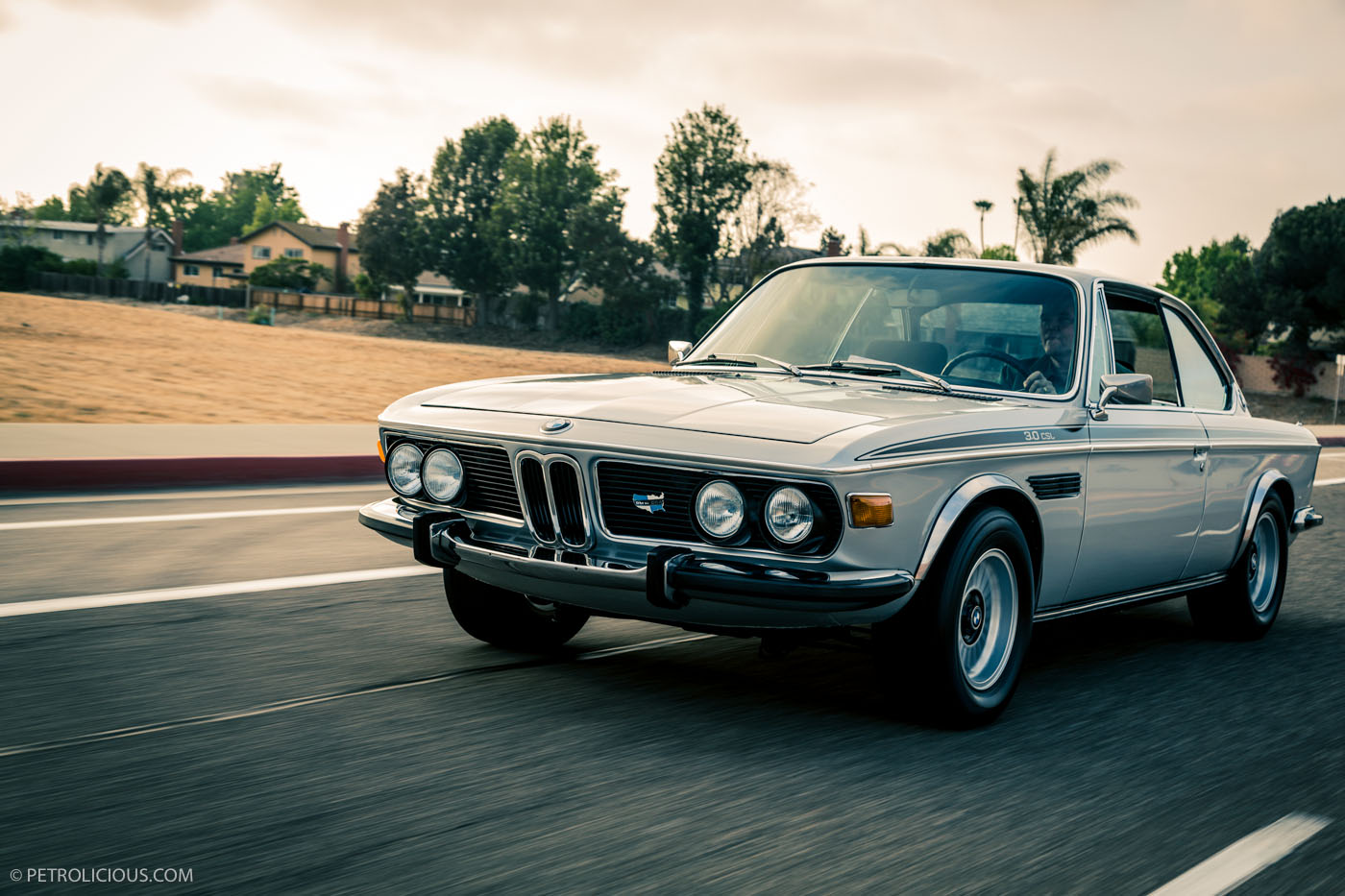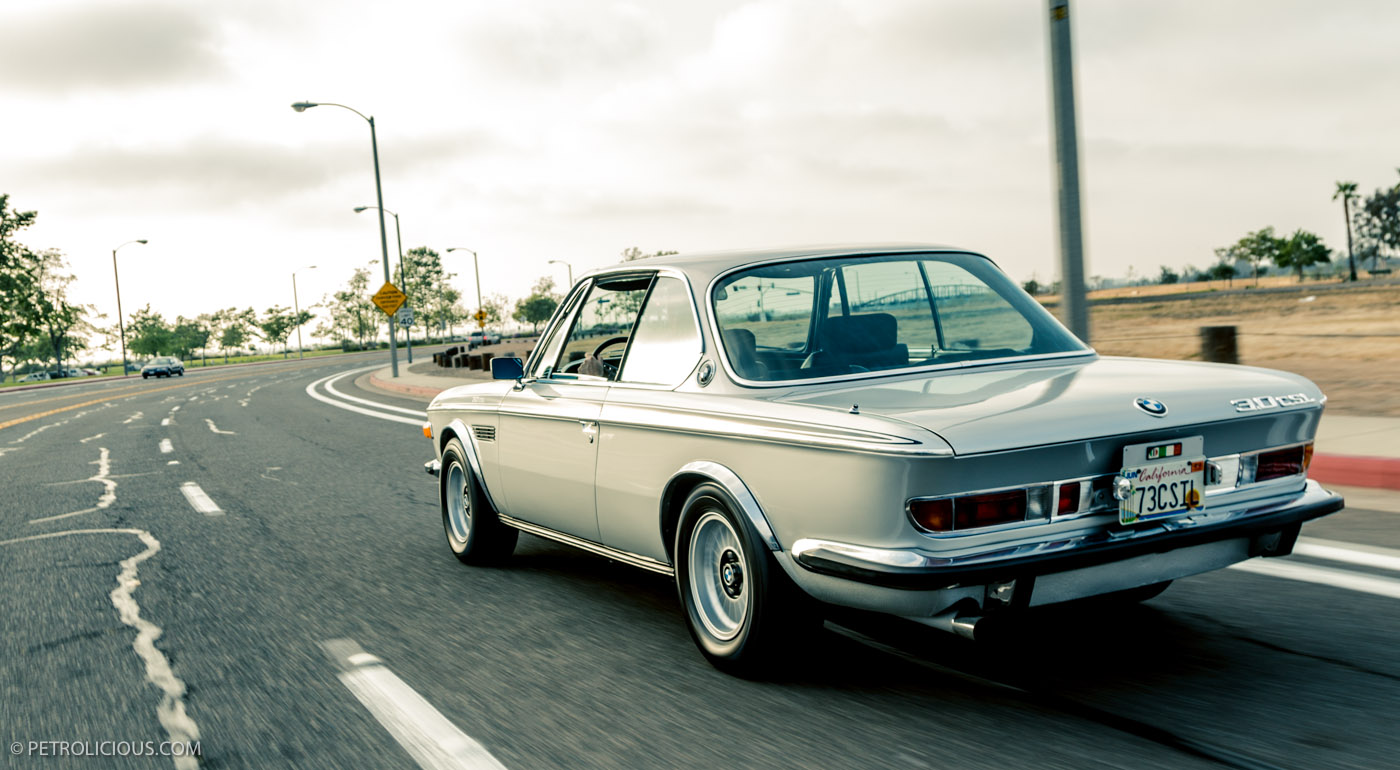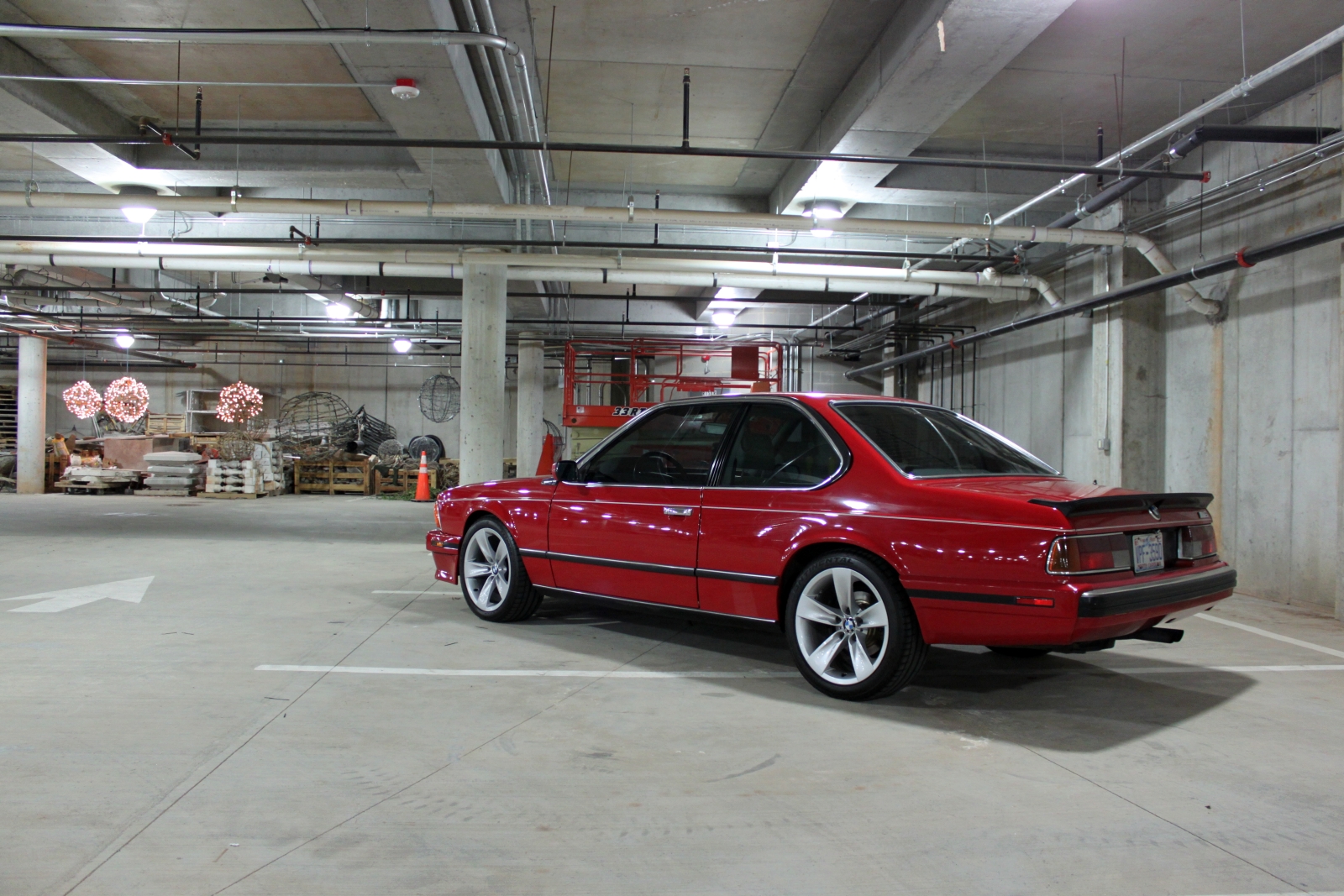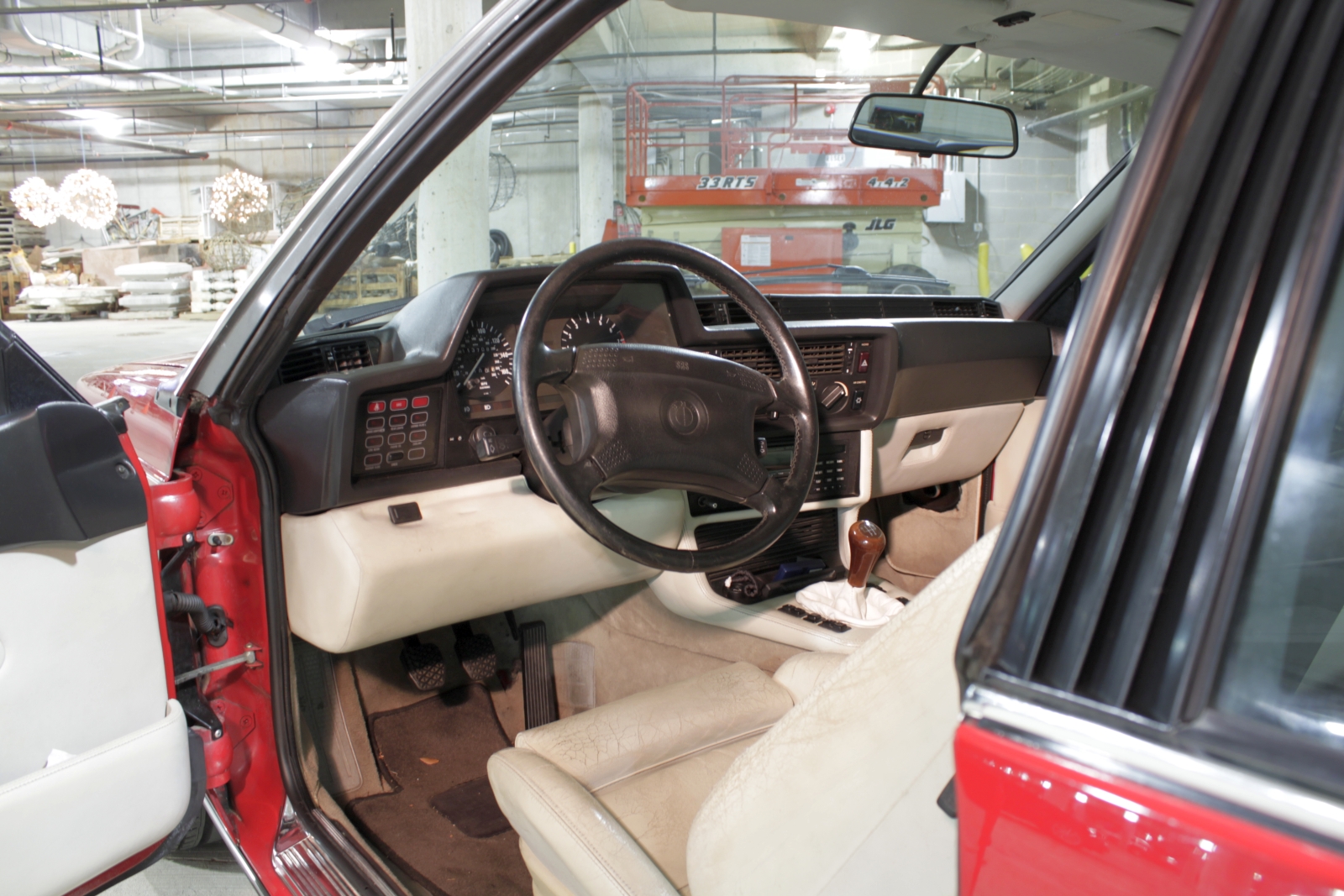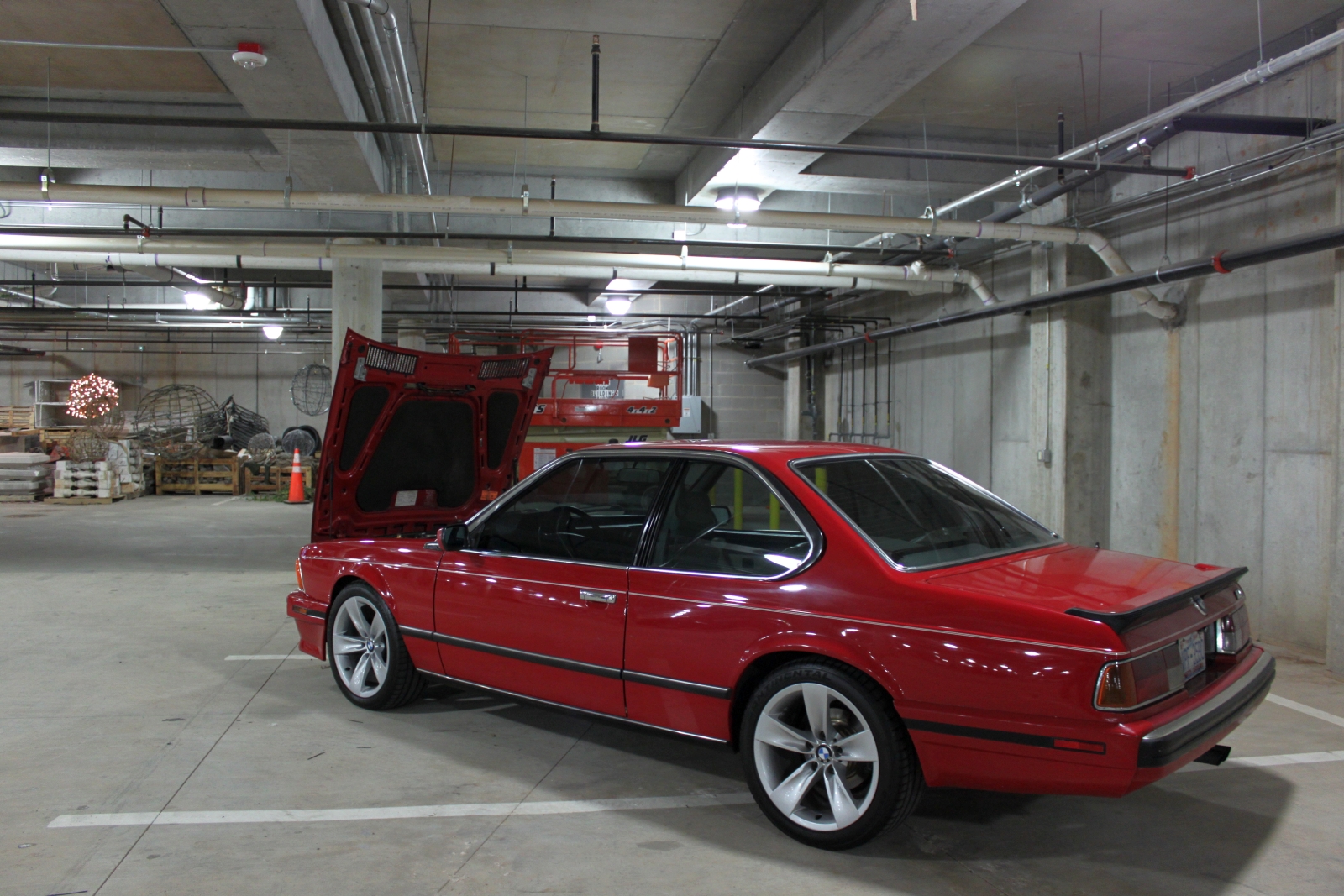One of the most iconic and recognizable cars in BMW’s history is the E9 coupe. The classy coupe is skyrocketing in value because of the rarity and well-known beauty and elegance. As a great article by Petrolicious summed up, the BMW E9 was a luxury vehicle designed for those not willing to compromise in performance.
Internally known as the E9, it first debuted in 1968 as a luxurious grand-tourer designed to carry BMW’s new M30 inline-six engine. Designed under Wilhelm Hofmeister, the same Hofmeister famous for the BMW window kink, it isn’t too surprising to find Bertone’s design sensibilities a couple of generations back. Bertone designed the BMW 3200CS, a V8, which would eventually become the 2000CS and the BMW E9 chassis.
Proportionally, the 3.0CS does a masterful job of deceiving the eye. It is a truly beautiful car, and there is a successful combination of elements designed to hide certain packaging constraints. For instance, the doors are mounted closer to the front wheels than rear, which is most certainly not a front engine, rear-wheel drive look. Yet because the E9’s greenhouse extends so far back creating a short rear deck, the silhouette of the car absolutely speaks to the correct proportion.
Yet in spite of having a rather tall greenhouse (and thus wonderful sightlines, one of the reasons it’s so good to drive), the car is gorgeous. You can credit the slender pillars for minimizing the greenhouse’s visual weight (one of the key elements retained from the original Bertone 3200CS). The overall visual lightness of the cabin is mirrored in the entire car itself, more on this in a moment though.
The surfacing is evolutionary, at best, as it remained fairly consistent from previous BMW coupes. But the beltline that carries your eye from front to back beginning with the negative front end form a very strong, classic theme. It is that negative front end coupled with the negative rear that give the car its aforementioned visual lightness. The E9 is ready to move! Additionally, the slight wheel flares accentuate the tires giving the car a slightly more muscular look.
Use of chrome is fairly extensive on the BMW 3.0CS, but it was aimed at the luxury market and more importantly looks good. It is however generally limited to window trim, bumpers, and a few other bits. The only other details on the road-going version of the car worth mentioning are the vents on the front fenders and the roundel on the C-pillar, which accentuates the pillars’ base. This is also where the lithe pillars are sacrificed in the name of fashion, to great effect for the Hofmeister kink. The added bulk provides a nice bit of mass over the rear axle emphasizing the BMW’s rear-wheel drive platform.
Unlike many cars of the era whose wheels and tires sit a bit inboard, the E9’s stance is purposeful. Additionally, as Sir Francis Bacon said, “there is no excellent beauty that not some strangeness in the proportion.” Applied to the 3.0CS, that strangeness may be the height of the cabin compared with the rest of the body. Indeed it is a beautiful car and this one facet of the design is especially pleasing today, when the vast majority of cars trend toward a hunkered appearance. Whether spawned by Bertone or refined by Herr Hofmeister, in spite of some awkward packaging requirements the E9 remains airy, sporty, and accessible.
So when BMW finally came to determining a vehicle to replace it in the product offering, there was an arduous task ahead of them. BMW wanted to retain the exclusivity of their flagship grand touring coupe, along with giving it modern amenties, such as the newly designed fuel injection systems as placed on the M30B30 engines.
In designing the E24 6 Series to suit multiple markets, designer Paul Bracq, who created the BMW Turbo in 1972, confronted the reality that BMW doesn’t always mean the same thing in Germany as it does in the US. It was a time to revel in traditional BMW styling, performance and personality. As it is even today, the German concept of sporting luxury does not always translate into American notions of, well, comfort luxury. Unfortunately, the new flagship line seemed the 6 series would become slightly larger and heavier than previous models (a trend found in modern BMW’s as well!). In 1977, the first year of the U.S. E24, it carried up to 350 lb more than the previous 3.0 CSi.
But in all fairness, the E24 had to be able to withstand added crash worthiness requirements. BMW really got serious about the front and rear crumple zone, reinforced roof panel, a bar extending the width of the cockpit behind the dashboard and reinforced rear bulkhead behind the back seat. U.S. models, of course, carried on with the big aluminum “crash bumpers.”
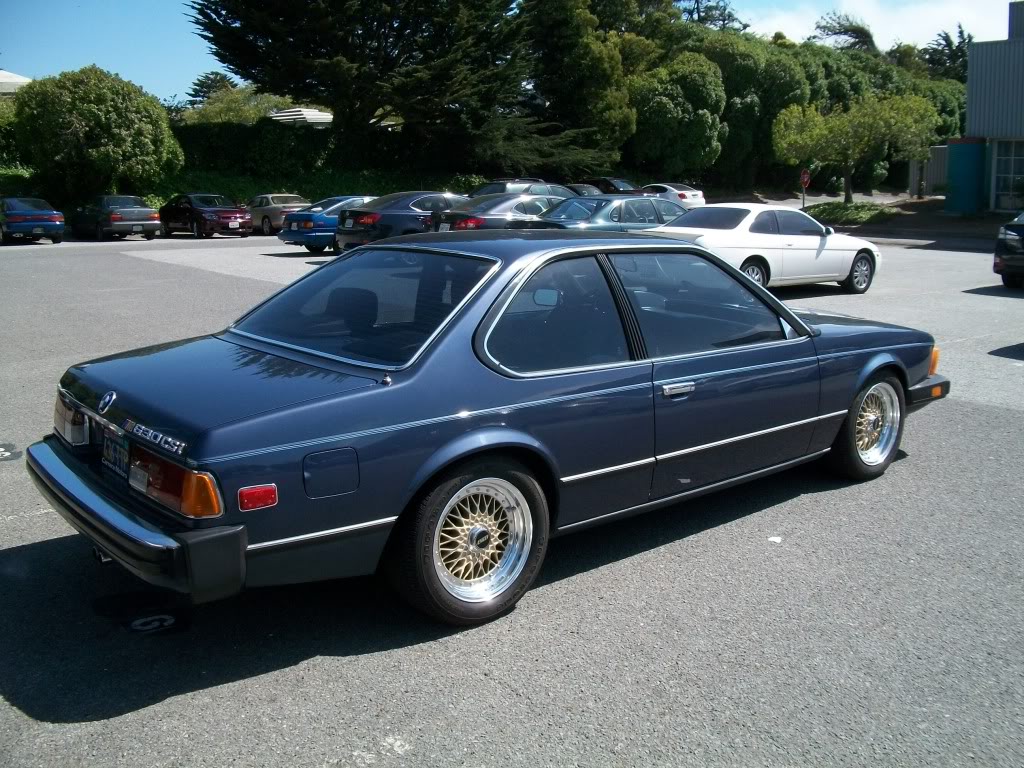
Now, it’s a fact of life that everything gets bigger and heavier in time–cars as well as people. We are willing to put up with added girth in return for function and practicality. But what happened to U.S.-spec E24 engines was just a sin. American emissions laws mandated use of a positively horrible exhaust gas recirculation (EGR) system that eventually cooked cylinder heads on the M30 engines (Also seen on previous E3 and E9’s such as The Brown Bomber). High-compression pistons were out of the question due to emissions restrictions, and, in fact, low compression was the order of the day due not only to the EGR system but also to the demise of serious high-octane gasoline. Remember, this was way before the knock-sensing ignition emerged to save the day for compression ratios. The result was that horsepower and torque nosedived to meet US Federalization requirements for sale in America.
This was a big problem for us Americans looking for an elegant GT coupe. You can’t exactly have a grand-tourer if the performance parts have all been detuned, and the remainder has been overly saturated with luxury items, now can you?
Fortunately, there was in answer…
(story and photos found via CarThrottle)
1988 BMW M6 Test Drive
One must maintain perspective when driving an old car. You hear legends and stories about how great something was, but you have to remember that it was during the time period where things were much different than today. Best example of this: old school muscle cars from the 60’s. Sure, they’re cool, but back in the day they were some of the fastest things with wheels. If you lined up a Chevelle SS396 with a 4-speed against a brand new, stock 2.0L Volkswagen GTI, the VW would get it’s lunch handed to it in almost every way possible.
So when I was given the opportunity to slide behind the wheel of a 1988 BMW M6, sure I was excited. It’s one of my all-time favorite BMWs; the E24 6-series has always held a pretty high spot on my list of classic BMW’s, and the M6 was the top-dog of the 6-series line. At the time of production the 6 series was BMW’s flagship model. It was also one of the best performing cars you could get your hands on in 1988. Only one of 1,700-odd M6’s imported to the US over two years. But come on; this a 23-year old BMW. How great can it actually be?
Maybe I’m biased. I drove around in a 23-year-old European car for more than a year, and despite some modern features it was really quite archaic. But then again, the 900 SPG had a lot of Saab 99 DNA under the hood; DNA that dated back to the late 60’s. It was delightfully outdated when it was new. The 6’er, on the other hand, was not.Like most M cars then and today, the M6 is all about the engine. While normal 6-series used M30 derivatives (the strongest of which being the 635CSi which had a 3.5L 180bhp motor), the M6 was a bit more exotic under the hood. Called the S38B35, it was derived from the M88 straight-six which sat behind the passengers in the original BMW M1 supercar. The S38 was civilized a bit for street car duty, but it still enjoyed most of the race-derived technology that made it so desirable. While European E28 M5’s and E24 M6’s received the 282bhp M88/2 motor, the US market got a slightly detuned version. Changes include a double-row timing chain, lower compression ratio, tubular exhaust manifolds (non-equal length), and the addition of a catalytic converter to meet emissions standards.
Power on the US spec engine was down to 256bhp (from 282) at 6,500rpm but torque was hardly changed, 243lb-ft (from 251) at 4,500. The S38’s distinct calling card was the row of individual throttle bodies for each cylinder, instead of one huge one. All M6’s were mated exclusively to a five-speed manual transmission with a limited-slip differential (although other E24’s were available with an automatic.)
M6’s in the US (sold between 1988-1989) came with a lot of impressive luxury features standard. The rear seat had it’s own dedicated A/C system with separate controls and a drink cooler(!), the front seats were highly bolstered power-adjustable units, and a premium stereo was standard.
Stepping into the M6, a few things strike you. Primarily, compared to most modern sports coupes, visibility is amazing. The E24 has a huge greenhouse (glass area) and thin A-pillars, so blind spots are not an issue. This is something I wish modern coupes took into consideration; sitting in a modern Camaro makes you wonder who the designers had in mind (midgets with X-Ray vision?) when they laid out interior. The other thing is how damn comfortable those seats are:
Most cars from the 80’s have pretty bad seats. The science of ergonomics has come a long way in the last 30 years, and it shows. But with 23 years and 116,000 miles under their belts, M6 seats still hold you in place like a vice, yet you sink into them like your favorite couch. They’re absolutely wonderful, and they adjust in so many ways that if you can’t find a good driving position you’re probably just not trying hard enough.
The outside of the car is… Oh, I’ll be honest: it’s hard to retain journalistic integrity when reviewing an M6. I’ve loved the E24’s lines since I first saw one years ago, and I still believe it’s one of the best looking BMW’s ever made. That forward-pointed grille with wide-set quad headlights is the definition of menacing, and the simplicity of the design harkens back to an era when BMW’s were made to impress those that owned them, not their neighbors. The one odd thing on this particular car are those modern 5-series wheels (off an E60 530i, I believe.) They look out of place, but there’s a logical explanation. All M6’s in the US came with metric-sized wheels and Michelin TRX metric tires, which was the cool thing to do in the 80’s. After Michelin realized that making standard and metric sized tires was pointless, they sold the molds to Coker, who still makes them today (For unbelievably high prices). The solution is fitting modern standard-sized wheels with the right bolt pattern and offset, and enjoying the benefits of decades-newer tire design at sane prices.
Insert the key into the ignition, push the heavy clutch in, and fire it over. The big straight six cranks for a short second and bursts to life, with a little bit of a loping idle as it warms through. It’s a far less synthetic sound than a modern engine starting, you can actually hear the lifters and valvetrain working. Once it gets closer to operating temperature, all the various sounds fade into a harmony, and it’s time to go.
The M6 is a delightfully mechanical car, despite the relative amount of sophistication present in it given the time frame in which it was produced. The clutch has a weight and feel to it that’s just simply lacking in modern cars; if you didn’t have a strong left leg when you started daily driving this car, you would in a week. The gear shift is set far forward and has BMW’s traditionally long, ropey throws – yet it somehow manages to avoid being imprecise, but rather it’s laid back. Clutch takeup is sharp, but with the driveline in good shape (fresh motor mounts and guibo), you’re soon on your way.
The steering is heavy – proper heavy – another attribute of older cars. At first you’re apprehensive, thinking about how old and complicated the car is, treating it like a museum piece. But within a mile you realize the M6 is not a museum piece, it’s not just for taking to Cars & Coffee; it’s a driver’s car, the type of car that the Camry-driving proletariat would absolutely hate. The feel of solidity to the car is palpable, and everything feels like it’s exactly where it should be. The suspension – the rear suspension since converted from self-leveling hydraulics to static shocks – doesn’t beat you up, but it’s firm enough to remain perfectly composed on a winding road.
And that engine – oh, that engine. It’s incredible. Of course, the sound and feel is amazing – dip into half throttle in second gear, and you can hear all six throttle butterflies open up, sucking in atmosphere and turning it into horsepower. Throttle response is amazing; you don’t get reactions like this with a modern, single throttle-body drive by wire car. But the power is what impresses most. You look at the figures and you might not be impressed; a modern V6 Accord makes more power and torque than the M6, but it still feels every bit the legend it was back in the day. The crescendo of all those valves and throttle bodies as the tach swings up is just amazing, and even by my jaded, modern standards the M6 is proper quick. Must be something to do with that dual overhead cam breathing efficiency at the higher revs.
The mid-range torque impresses most; you always think you should be in a lower gear than you are, but you’re most likely wrong. The large displacement coupled with the fantastic flow through the cylinder head lets the S38 punch much higher than it’s weight. This car is someone’s baby, so I won’t make up tales of bouncing the rev limiter and stepping sideways on gear changes – I only beat my own car like that. But the performance of the M6 is distinct from a lot of the performance Hondas I’m used to. With a car like a Civic Si or an S2000, to be impressed by the power you have to have your foot flat to the floor, passing the high-lift cam changeover at 6,000 rpm, and bouncing off the rev limiter. With the M6, you dip halfway into the throttle, and it pushes you into your seat. You can tell just how earth-shaking this engine was in the 80’s; it’s amazing even today.
It doesn’t suffer from any of the idiosyncratic hiccups that early fuel-injected cars sometimes do; there’s no part throttle stumbles or weird lumpy idle when cold. The sound is unique: much deeper and richer than the somewhat tinny-sounding E46 M3, but it’s still an orchestra of noise. It’s geared relatively long, making for sedate highway cruising, and the long wheelbase and wide track make it quite stable. The brakes have a much heavier pedal than modern cars, but there’s plenty of feel – and stopping power.
Is this a relevant review of something you’d consider for a daily driver? No, it’s a 23 year-old BMW M Car. They’re expensive to maintain and hard to find parts for. They’re fussy (not Ferrari fussy), and not the latest word in safety. No, the point of this test drive was: when you meet your heroes, do they stand up to your expectations?
My answer, at least as pertains to the M6, is a resounding “yes.”
BMW enthusiasts danced in streets all across America for the 1987-88 model year. In a one, two, three punch, BMW of North America brought us the M3, M5 and M6 in rapid succession. Investments were sold. Mortgages were assumed. Work hours were increased. Marriages were dissolved. Power-starved Americans needed M cars. The “Highline” models had all the luxury equipment to make the standard 6 series turn into a ravaging monster at heart, dressed in a supple leather interior and GT coupe exterior.
Still, the U.S.-spec M6 represented a severely detuned version of the fire-breathing European M635CSi, but the fact remained that North America now had the real double overhead cam engine. The hard edges of the interior were softened for 1988-89 with authentic Napa leather. A very luxurious rear seat air conditioning unit and an armrest beer cooler were perfect for those long road trips through Texas. Sport seats were, of course, standard.
Outside, the big news was BMW’s switch to “world” bumpers for the 1988 model year, relegating the previous bumpers obsolete and outdated. Ellipsoid technology headlights allowed a slight improvement for U.S.-legal headlight efficiency. BMW’s self-leveling rear suspension now found its way into the M6, using a complex electro-hydraulic system to maintain rear ride height regardless of squat, dive or vehicle load. The system works quite well but is very pricey to repair in its old age. Confronted with the need for new rear shocks or a hydraulic pump, many owners simply convert the car to a conventional rear suspension. This involves capping the hydraulic lines, disconnecting the electrical harness and fitting “normal” rear shocks and non-self-leveling rear coil springs. All of these luxury items were standard in North America, but merely options for the rest of the world.
A beefier Getrag 280 five-speed overdrive manual gearbox graced the M6, as did a lower 3.91 limited-slip differential to offset the reduction of power that came with the emissions equipment. Larger brakes augmented grip from 240/45VR-415 Michelin TRX tires mounted on single-piece alloy TRX wheels. Outside, Motorsport spoilers provided downforce for great stability and road-holding for autobahn-esque cruising.
The M6 is the ultimate U.S.-spec E24 6 Series although still overshadowed in collector appeal by European-version 6ers. It is a unique vehicle that was finally able to become a proper successor to the E9 coupe.
Latest posts by Tom Schultz test #2 (see all)
- 2025 Event Details - 13 May, 2025
- 2024 Durango Event - 24 February, 2024
- Drive 4 Corners 2022 Low-Key Event Concluded - 1 September, 2022



